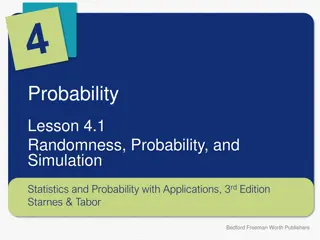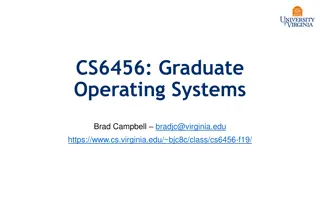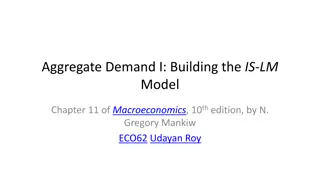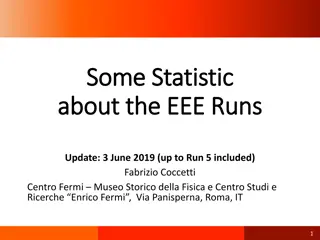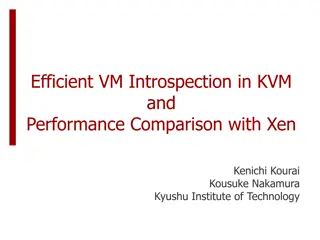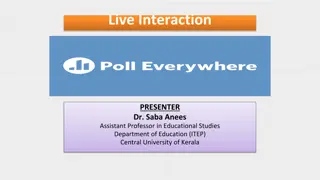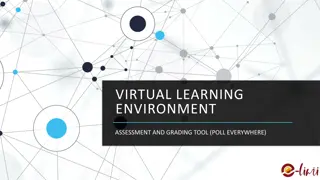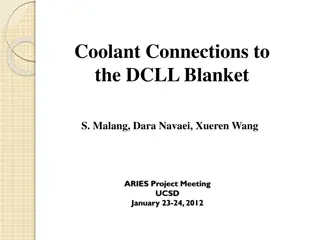Xen-Blanket: Virtualize Once, Run Everywhere
The Xen-Blanket, introduced by Hakim Weatherspoon, aims to address challenges in cloud computing such as lack of interoperability and efficient resource utilization. It enables uniform VM images, advanced hypervisor management, and seamless migration between clouds. The second-layer hypervisor enhances inter-cloud migration and control over cloud networks, offering solutions for enterprise workloads and supercloud interoperability.
Download Presentation

Please find below an Image/Link to download the presentation.
The content on the website is provided AS IS for your information and personal use only. It may not be sold, licensed, or shared on other websites without obtaining consent from the author.If you encounter any issues during the download, it is possible that the publisher has removed the file from their server.
You are allowed to download the files provided on this website for personal or commercial use, subject to the condition that they are used lawfully. All files are the property of their respective owners.
The content on the website is provided AS IS for your information and personal use only. It may not be sold, licensed, or shared on other websites without obtaining consent from the author.
E N D
Presentation Transcript
Data Center Virtualization: Xen and Xen-blanket Hakim Weatherspoon Assistant Professor, Dept of Computer Science CS 5413: High Performance Systems and Networking November 17, 2014 Slides from ACM European Conference on Computer Systems 2012 presentation of The Xen-Blanket: Virtualize Once, Run Everywhere and Dan Williams dissertation
Goals for Today The Xen-Blanket: Virtualize Once, Run Everywhere D. Williams, H. Jamjoom, and H. Weatherspoon. ACM European Conference on Computer Systems (EuroSys), April 2012, pages 113-126..
Background & motivation Infrastructure as a Service (IaaS) clouds Inter-cloud migration? Uniform VM image? Advanced hypervisor level management?
research challenges Lack of interoperability between clouds How can cloud user homogenize clouds? Lack of control in cloud networks What cloud network abstraction enables enterprise workload to run without modification? Lack of efficient cloud resource utilization How can cloud users exploit oversubscription in the cloud while handling overload? 5
Xen-Blanket A second-layer hypervisor Inter-cloud migration? Uniform VM image? Advanced hypervisor level management? VM VM VM VM VM VM Xen-Blanket
Xen-Blanket Xen-Blanket (Eurosys 12) HVM guest Xen-Dom 0 HVM guest Xen-Dom 0 Dom 0 Dom U Ring 3 App App Kernel Kernel Ring 1 Kernel Kernel Xen-Blanket Kernel Ring 0 Xen Xen
contributions towards superclouds Cloud interoperability Enable cloud user to homogenize clouds The Xen-Blanket Enterprise Workloads VM VM VM VM VM VM Supercloud Cloud Interoperability (The Xen-Blanket) Third-Party Clouds 8
contributions towards superclouds Cloud interoperability User control of cloud networks Enable cloud user to implement network control logic VirtualWire Enterprise Workloads VM VM VM VM VM VM User Control of Cloud Networks (VirtualWire) Supercloud Cloud Interoperability (The Xen-Blanket) Third-Party Clouds 9
contributions towards superclouds Cloud interoperability User control of cloud networks Efficient cloud resource utilization Enable cloud user to oversubscribe resources and handle overload Overdriver Enterprise Workloads VM VM VM VM VM VM Efficient Cloud Resource Utilization (Overdriver) User Control of Cloud Networks (VirtualWire) Supercloud Cloud Interoperability (The Xen-Blanket) Third-Party Clouds 10
roadmap: towards superclouds Cloud interoperability User control of cloud networks Efficient cloud resource utilization Enterprise Workloads VM VM VM VM VM VM Efficient Cloud Resource Utilization (Overdriver) User Control of Cloud Networks (VirtualWire) Supercloud Cloud Interoperability (The Xen-Blanket) Related work Future work Conclusion Third-Party Clouds 11
Clouds are not interoperable Image format not yet standard AMI, Open Virtualization Format (OVF) Paravirtualized device interfaces vary virtio, Xen Hypervisor-level services not standard Autoscale, VM migration, CPU bursting Need homogenization (consistent interfaces, services across clouds) 12
provider-centric homogenization Rely on support from provider VM 1 VM 2 VM 3 VM 4 May take years, if ever (e.g., standardization) INTERFACE INTERFACE Cloud A Cloud B Least common denominator functionality Consistent Consistent Hypervisor- level Services VM/Device/Hypervisor Interfaces 13
user-centric homogenization No special support from provider VM 1 VM 2 VM 3 VM 4 INTERFACE Can be done today Custom, user- specific functionality INTERFACE 1 INTERFACE 2 Consistent Cloud B Cloud A VM/Device/Hypervisor Interfaces Consistent Hypervisor- level Services 14
nested virtualization approaches Require support by bottom level hypervisor No modifications to top-level hypervisor The Turtles Project (OSDI 10) (provider-centric) No support from bottom level hypervisor Modify top-level hypervisor The Xen-Blanket (user-centric) 15
the xen-blanket User 1 User 2 Assumption: Existing clouds provide full virtualization (HVM) VM VM VM Xen-Blanket User controlled VMM Xen-Blanket User controlled VMM Future work: Xen-Blanket in paravirtualized guest Xen / KVM Provider controlled VMM Hardware No support for nested virtualization 16
without hypervisor support No virtualization hardware exposed to second layer Can use paravirtualization or binary translation We use paravirtualization (Xen) Heterogeneous device interfaces Create set of Blanket drivers for each interface We have built drivers for Xen and KVM (virtio) 17
PV device I/O Paravirtualized device I/O essential for performance Ring 3 Dom 0 Guest KernelUser Ring 1 Physical Device Driver Backend Driver Frontend Driver Domain 0 hides physical device details from guests Ring 0 Xen Hardware 18
PV-on-HVM HVM guest still needs PV device I/O Ring 3 Dom 0 HVM Guest Kernel User Ring 1 Physical Device Driver Backend Driver Platform PCI Driver makes Xen internals look like PCI device HVM Frontend Driver Ring 0 Xen Physical device details still hidden from guests Hardware Xen Platform PCI Driver 19
blanket drivers Physical device details are hidden from entire Xen-Blanket instance Dom 0 HVM Guest Ring 3 Dom 0 Guest Ring 1 Physical Device Driver Backend Driver Blanket Frontend Driver Backend Driver Frontend Driver Blanket Frontend Driver interfaces with provider-specific device interface like PV-on-HVM Ring 0 Blanket Hypercalls Xen-Blanket Xen Provider-specific device interface details are hidden from second-layer guests Hardware 20
technical details Address translation Virtual addresses are two translations from machine addresses (needed for DMA) Hypercall assistance Communication between frontend blanket driver and backend driver vmcall must be issued from ring 0 Most hypercalls are passthrough Many more details in thesis 21
overhead evaluation setup Used up to 2 physical hosts (six-core 2.93 GHz Intel Xeon X5670 processors, 24 GB of memory, four 1 TB disks, and 1 Gbps link) 22
lmbench microbenchmarks Native ( s) HVM ( s) PV ( s) Xen-Blanket ( s) Null Call 0.19 0.21 0.36 0.36 Fork Proc 67 86 220 258 Ctxt switch (2p/64K) 0.45 0.66 3.18 3.46 Page fault 0.56 0.99 2.00 2.10 Compare Xen-Blanket to PV 23
blanket driver overhead Two VMs on two physical hosts using netperf Can receive at line speed on 1Gbps link Within 15% CPU utilization of single layer 24
kernbench Up to 68% overhead on kernbench APIC emulation causes many vmexits 25
user-defined oversubscription CPU (ECUs) Memory (GB) Disk (GB) Price ($/hr) Type Small 1 1.7 160 0.085 Cluster 4XL 33.5 23 1690 1.60 Factor 33.5x 13.5x 10x 18.8x Resources do not all scale the same as price Opportunity to exploit CPU scaling 26
kernbench revisited kernbench kernel compile benchmark Rent one 4XL EC2 instance Use Xen-Blanket to partition it 40 ways All instances (on average) finished the same time as EC2 small instance 47% price reduction per VM per hour 27
cloud interoperability The Xen-Blanket User-centric homogenization Nested virtualization without support from underlying hypervisor Runs on today's clouds (e.g., Amazon EC2) Download the code: http://code.google.com/p/xen-blanket/ New opportunities performance: user-defined oversubscription 28
Before Next time Project Interim report Due Monday, November 24. And meet with groups, TA, and professor Fractus Upgrade: Should be back online Required review and reading for Wednesday, November 19 Extending networking into the virtualization layer, B. Pfaff, J. Pettit, T. Koponen, K. Amidon, M. Casado, S. Shenker. ACM SIGCOMM Workshop on Hot Topics in Networking (HotNets), October 2009. http://conferences.sigcomm.org/hotnets/2009/papers/hotnets2009- final143.pdf Check piazza: http://piazza.com/cornell/fall2014/cs5413 Check website for updated schedule







